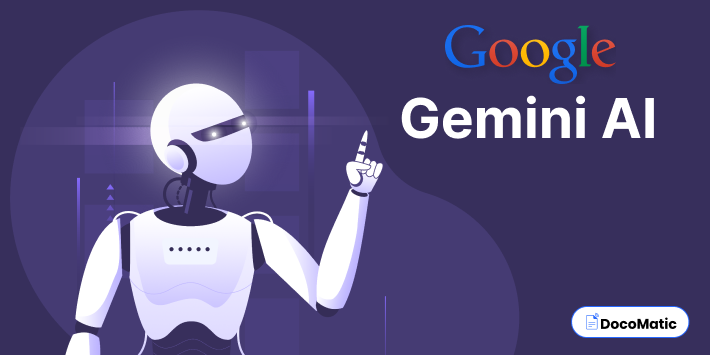Key Takeaways:
1. Gemini AI, a significant AI generative model transforms the way AI engages with the world.
2. Gemini AI aims to surpass the limitations of conventional AI systems.
3. Gemini is a collaborative effort across Google, including Google DeepMind and Google Research.
4. Gemini was released in three different sizes – Nano, Pro, and Ultra, to cater diverse range of tasks and devices.
On one side, where artificial intelligence is reshaping the boundaries of technology, Google DeepMind’s Gemini AI emerges as a groundbreaking innovation.
This generative AI model by Google has come up with an idea to revolutionize the way AI understands and interacts with the world. With its promising capabilities, this large language model is all set to raise our understanding and interaction level with the digital environment.
Here in this blog, we will delve into the core of Gemini, the minds behind the development of Gemini, and how it works.
Table of Content
What is Gemini?
Gemini is the latest multimodal solution by Google which is capable of processing a wide array of information types. It understands and analyzes several data types—such as text, photos, audio, and video—at the same time.
This generative AI model incorporates advanced training techniques. It is intended to surpass the limitations of conventional AI systems. It can also comprehend real-world operations because of its multimodal capabilities.
Gemini is surely an essential step forward in the quest to construct AI systems that are more intelligent, adaptable, and intuitive.
It creates new opportunities for AI applications, transforming it into a tool for obtaining comprehensive knowledge from diverse sources and contexts.
Here are some basic stuff to know about Google’s Gemini:
- The initial announcement for Google Gemini was done immediately after the launch of Bard, Duet AI, and Google’s PaLM 2 LLM.
- The first introduction of this AI generative model was at the Google I/O developer conference in May 2023,
- Gemini is currently integrated with Google Bard and the Google Pixel 8. Eventually, it will be further integrated into other Google services as well.
- At present, the datasets of Gemini have been massively trained on Google-made tensor processing units or TPUs. However, in the future Gemini will be trained on both TPUs and graphics processing units (GPUs), said Amin Vahdat, vice president of Google’s Cloud AI, in a briefing.
- This advanced AI model is being promoted as a significant advancement in natural language processing, with Google calling it “our largest science and engineering project ever.”
Who Made Gemini?
Gemini is developed by Google and Alphabet, Google’s parent company. Google considers the development of Gemini as the most advanced AI model to date. Google DeepMind also contributed significantly to the development of Gemini.
Dennis Hassabis, CEO and co-founder of Google DeepMind says “Gemini is the result of large-scale collaborative efforts by teams across Google, including our colleagues at Google Research. It was built from the ground up to be multimodal, which means it can generalize and seamlessly understand, operate across, and combine different types of information including text, code, audio, image, and video.”
How Google’s Gemini AI Works?
Fundamentally, Gemini AI uses sophisticated neural networks—a kind of machine learning—to handle and examine various kinds of data.
This large language model has been trained on the massive datasets of Tensor Processing Units (TPUs) jointly across image, audio, video, and text data to build a model with strong generalist capabilities across modalities. They take textual input and a wide variety of audio and visual inputs, such as natural images, charts, screenshots, PDFs, and videos, and produce text and image outputs.
This makes it perform well on understanding and reasoning in multi-modal tasks for different domains.
The large datasets are used to train these neural networks, which helps the AI recognize patterns and subtleties in the data.
Here is an example of how Gemini AI works:
When Gemini was asked, “Suggest some ideas on what could be made from the woolen balls (shown in the video 👆),
here is what Gemini has to say,
Gemini: How about an Octopus with blue and pink tentacles?

Source: deepmind.google
One of the key strengths of Gemini AI is its ability to perform complex tasks that require an understanding of multiple modalities.
- For example, in language translation, Gemini AI can consider both the spoken words and the context provided by visual cues to deliver more accurate translations.
- In healthcare, it can analyze medical images while considering clinical notes to assist in diagnosis.
The technology behind Gemini AI is not just about integrating different data types; it’s also about understanding the relationships and interactions between these modalities. This understanding is what sets Gemini AI apart and fuels its potential to revolutionize various industries, from healthcare and education to entertainment and beyond.
Different Variants of Gemini
Google considers Gemini as a flexible model because of its capability to run on everything right from Google’s Centre to users’ mobile devices. To achieve the said scalability, Gemini is released in three different sizes: Gemini Nano, Gemini Pro, and Gemini Ultra.
1. Gemini Nano – The on-device powerhouse
Google Gemini Nano was developed with the intent to ease out the on-device tasks. It is typically designed to run on mobile devices, specifically the Pixel 8 Pro. Gemini Nano is the ‘lite’ model of the LLM. it is available in 2 sizes: Nano-1 (1.8 billion parameters) and Nano-2 (3.25 billion parameters). Nano will boost the mobile-enabled tasks (that require AI processing) like text summarization or suggesting replies in messaging apps.
2. Gemini Pro-The versatile powerhouse fueling chatbots
Powering Google’s recent chatbot application Bard, Gemini Pro is all set to compete with OpenAI GPT-3.5 in six core benchmarks. According to Google, Gemini Pro is more effective in performing tasks like brainstorming, writing, and summarizing content.
3. Gemini Ultra- The super-powered model
Gemini Ultra was created to handle the large and the most complex tasks. Though, it is unavailable for widespread use at a given moment, it is still the most capable model. It is finely trained on various codebases. It can comprehend complex queries in text, code, and audio format. It also answers questions related to complicated topics. Google’s Gemini Ultra has successfully surpassed other existing LLMs on around 30 of the 32 wide benchmarks used for LLM evaluation.
That’s All!
Conclusively we can say that through this innovation, Google is not just enhancing the capabilities of AI systems but is also bringing them closer to a human-like understanding of the world with AI.
As we will continue exploring and refining this technology, we will get to know that the potential applications and impacts of Gemini AI are boundless.
Hopefully, this edge-cutting advancement by Google stands as a beacon of the future of AI, a future where AI can interact with and understand the world in a way that was once the realm of science fiction.
